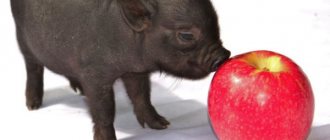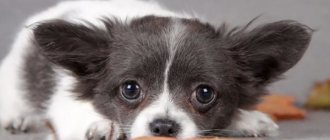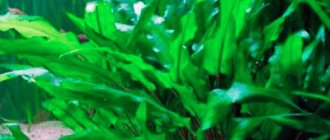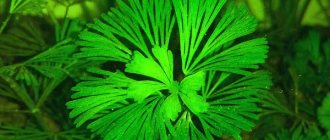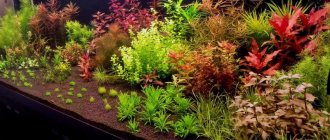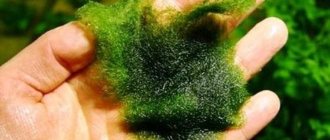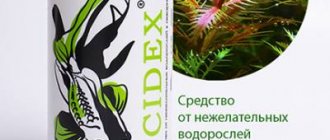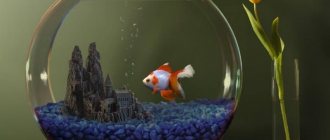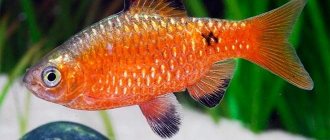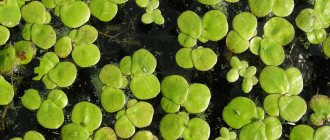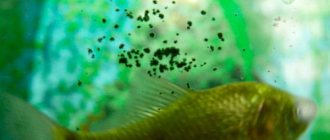Content
- 1 Description
- 2 Recommendations
- 3 Terms
- 4 Reproduction
Source: www.aquafanat.com.ua
- Other names: Cladophora spherical, Cladophora aegagropila, Aegagropila sauteri, Cladophora sauteri, Egagropila.
- Origin: Asia, Europe.
- Size: 3-10 cm.
- Temperature: 5-28 °C.
- Water parameters: pH 6-9, dKH 2-8 °.
- Lighting: moderate to strong.
- Growth rate: very slow.
- Content difficulty: medium.
Appearance and structure
Cladophora, the structure of which is distinguished by its originality, is a dense volumetric ball. The structure of moss is visually similar to felt. Inside the round moss ball are thousands of threads arranged in a radial direction, forming a frame. In adults, Egagropyla does not contain filamentous algae inside.
Aquarium Cladophora plants have their own daily cycle, which is divided into two moss states:
- staying at the bottom;
- stay near the surface.
The location of moss balls depends on the time of day and oxygen bubbles in the plant structure. As soon as the spherical cladophora gets rid of the air, it immediately sinks to the bottom of the reservoir.
Due to the absence of roots, the plant does not need soil. A dark green ball of elastic algae, floating peacefully in the water column or covering the bottom, gives the aquarium design originality and naturalness.
How to get rid of Cladophora in an aquarium - an effective method
Cladophora is a genus of green algae that has a filamentous structure. Sometimes called “green beard”. For aquarists, the definition to species does not make sense, since they differ only in anatomical structure. Therefore, in this article we will use the general designation of the species as Cladophora sp.
So, of all the algae found in the aquarium, Cladophora sp. - the most difficult species to breed. It is often confused with Aegagropila linnaei, which looks like a ball and is used to decorate aquariums. These are different types.
At the initial stages, cladophora looks like short branched threads. At this point, aquarists usually do not notice it or do not attach much importance to it. It becomes noticeable when a bundle is formed from individual threads. Typically, such a bundle has an attachment point to the substrate - a round point with a diameter of up to 1 mm. The threads themselves are short, dark green, and highly branched.
Outside of water, the threads retain a rigid structure and are rough to the touch. Also, if you rub the bunch with your fingers, you can hear a specific smell.
Having noticed such bunches, aquarists begin to try to remove them manually, which further contributes to the spread of cladophora throughout the aquarium. After all, every broken piece of thread is viable and will soon form a new bundle!
We suggest you read: Vitamins for puppies and adult German Shepherds
As a result, in a short time the algae completely covers the bottom of the aquarium and envelops ground cover and small-leaved plants. Can cling to glass and aquarium decorations, tubes, hoses. A dense carpet similar to moss can form at the bottom, which grows into every pebble of soil and can only be removed with the top part of the soil.
Cladophora enters the aquarium with newly acquired plant or fish species. An unnoticed thread on the stem of a plant or the fins of a fish will soon grow into a lush green clearing.
Very often Cladophora sp. enters the aquarium precisely with Aegagropila linnaei. It is impossible to distinguish the threads of Cladophora from the threads of Egagropilos without microscopic analysis. Egagropila often comes into mass sale from natural reservoirs on the surface, which quite often comes across Cladophora.
The main problem is that for its comfortable existence the same conditions are required as for aquarium plants. Therefore, trying to change the conditions (fertilizer application regime, light regime, water changes) is USELESS! If plants grow, Cladophora also grows.
The main thing she doesn't like is current. The flow speed affects the rate of thread formation. The stronger the current, the slower Cladophora sp. develops. It has been noticed that in places where the stream from the filter hits, this algae does not grow.
That is, the first step should be to ensure good water circulation in the aquarium and get rid of stagnation areas. This can be done by installing an additional internal filter aimed at the algae area. Sometimes this simple action is enough.
Among the biological enemies of Cladophora, Amano shrimp can be noted. But, firstly, these must be young shrimp, secondly, they must be hungry, and thirdly, the number of shrimp must be at least 30 per 100 liters. In our practice, no other inhabitants of the aquarium eat Cladophora.
An increased dose of glutaraldehyde or hydrogen peroxide will kill this algae. But it will kill most plants, not to mention living creatures. So what should we do?
The first step is to turn off the external and internal filters and the compressor to stop mixing the water. Never try to remove Cladophora fouling by hand! This leads to even more algae spreading throughout the aquarium!
We draw into the syringe the amount of algaecide that does not exceed the permissible value for the entire volume of the aquarium. For example, if you use Maksimov's Farm Algaecide, then during one treatment no more than 10 ml of algaecide per 100 liters of volume should enter the aquarium.
By slowly pressing the syringe plunger, we add Algaecide to the Cladophora foci in the aquarium. The main thing is not to make sudden movements. Pressing the piston and moving your hand in the aquarium should be as slow as possible so that the Algaecide does not mix throughout the aquarium.
The effect is noticeable after the first treatment. However, in order to permanently get rid of Cladophora in the aquarium, it is necessary to carry out 5-10 treatments. In 10 days, not a trace of this annoying algae will remain.
The chemical method effectively removes algae and, if the manufacturer’s dosage is followed, does not pose a threat to the inhabitants of the aquarium.
Keeping in an aquarium
Keeping algae in a pond is not recommended in the aquarium hobby, as they pollute the water and can cause deterioration in the condition of the fish. However, Cladophora globulus is an unusual algae that brings benefits to the inhabitants of the aquarium and the aquatic environment. It is a biological filter, purifying water from contaminants and saturating it with oxygen. In addition, Cladophora reproduces easily in an aquarium and looks great. For life expectancy and aesthetic appearance, it is necessary to maintain certain conditions and water parameters.
Cladophora spherical, the maintenance of which does not require much effort and time, can be placed in an aquarium of any size. Water indicators should be as follows:
- acidity – 4-6 units;
- hardness – up to 7 units;
- water temperature – 22C.
It is not recommended to exceed the water temperature, since reproduction and breeding of aegropile occurs when the temperature increases to 24C. In addition, in too warm water, the cladophora plant loses its beauty, growing inaccurately and losing its rounded shape. The mosses are restored to their previous appearance by lowering the temperature of the aquatic environment to cool for a month.
Also, algae are demanding on the purity of water, so replacement is carried out weekly, renewing 1/3 of the liquid. To contain Cladophora, you will need to install a filter in the aquarium.
Lighting for the pond is used moderately, with dim light. Too strong and bright rays initiate the accumulation of oxygen bubbles in the spherical cladophora.
Content recommendations
As already noted, one of the key characteristics for which the aegropile is so highly valued by aquarists, in addition to its appearance, is its unpretentiousness. Keeping Cladophora globulus in an aquarium is not particularly difficult and even beginners can do it.
Since Egagropyla is not a specially bred aquarium morph, but an algae of natural origin found in nature, many features of its existence in a home pond are directly related to its habitat in the natural environment.
Cladophora lives at the bottom of a reservoir in its natural environment; it should be placed in the same way in an aquarium.
Under natural conditions, Cladophora prefers to be located at the very bottom of the reservoir, where the sun’s rays practically do not penetrate. That is, the life of the algae passes, if not in complete darkness, then with minimal lighting. Therefore, when placing a plant in a tank, it is best to choose the darkest areas for it. The algae will feel comfortable:
- in the corners;
- behind or under snags;
- in the shade of spreading bushes or directly under their branches.
Due to the fact that Cladophora does not have a root system, it does not need soil. This algae is completely independent of the quality of the soil and its condition. The nature of the substrate does not affect its life.
Water requirements
One of the most important maintenance conditions is the water parameters. In order for the egagropyle to live “happily ever after”, you need to create a comfortable living environment for it. Most aquatic plants can be divided into two groups:
- freshwater;
- saltwater.
The amazing algae Cladophora can be included in both the first and second groups. The inhabitant of predominantly fresh water bodies still prefers brackish water. This is also confirmed by the fact that in the freshwater Japanese Lake Akan, where Cladophora lives, the density of algae colonies increases in places where natural springs with brackish water flow into the reservoir.
This preference also applies when Cladophora exists in the aquarium. The algae thrives in brackish water. Experienced owners of their own “underwater kingdoms” even recommend adding special salt to the water if the plant’s condition deteriorates—it begins to turn brown or yellow, etc.
In general, there are no special requirements for water parameters. The following indicators are recommended for the aquatic environment:
- alkalinity: medium;
- pH value (pH) - close to neutral level;
- hardness: low (maximum 8 degrees, a higher value will result in the death of the plant);
- temperature: plus 20−22 degrees Celsius (maximum 25).
The plant is easy to propagate, because cladophora itself disintegrates in warm water and forms new colonies.
In water that is warmer than desired, the plant can begin to grow rapidly. In addition, overheating can lead to consequences such as the destruction of algae - the balls will simply fall apart. On the one hand, this is a negative impact, on the other hand, the fragments into which the plant is divided can be successfully used for breeding cladophora.
Many aquarists around the world are cultivating Cladophora. This is not surprising - the plant has the highest decorative properties, is able to live in various tanks and is undemanding in terms of keeping conditions. If desired, you can use the pieces of aegropile formed after decay to form new algae colonies.
If increasing the number of plant representatives is not part of the plan, there is a way to “glue” the collapsed ball together. With timely cooling of water to normal, cladophora is able to gradually recover and return to its spherical shape.
Unwanted neighbors
The recommended temperature range excludes the possibility of keeping most varieties of tropical fish in the same tank with cladophora. For this reason, cold-water fish species usually become .
Various inhabitants of the underwater kingdom are very fond of the aegropile. For example, catfish and shrimp love to hide behind “plush” cladophora balls or sit on them. But, despite such addictions, these same creatures are capable of destroying the plant.
It is quite difficult to find fish that do not harm cladophora.
The decorative beauty of this algae compensates for the lack of representatives of aquatic fauna in the aquarium. If you really want to add aquarium animals to Egagropyla, you should approach the choice with the utmost caution. Neighborhood with individuals of plecostomus is certain death for the plant. Goldfish are also unfriendly towards this algae. The category of extremely undesirable neighbors also includes large crayfish, which do not get along not only with cladophora, but also with any aquatic vegetation.
Living clean
Like almost all aquarium inhabitants, Cladophora needs a change of water. In this regard, she is no exception to most representatives of the underwater world. Timely renewal of water is very important, it ensures:
- proper development of algal organisms and their growth;
- reduction in the content of nitrates in water, most of which are located in the bottom layer, where the plant is located half the day.
It is necessary to change the water frequently; cladophora, like a filter, absorbs all the debris in the aquarium.
In addition, changing the water prevents the algae from becoming contaminated, which happens quite often. Egagropil acts as a biological and mechanical water filter. It becomes a real aquarium “garbage collector” - various organic particles get stuck in small mossy cells. The function is useful, but the debris that accumulates on the surface of the plant gradually kills it.
Egagropila loves cleanliness. In addition to changing the water in the aquarium, you need to ensure good filtration and aeration. And, of course, in addition to purifying the water, you should take care of cleaning the algae itself. The plant does not require any special cleansing - just gently rinse it in clean water.
Caring for Cladophora globulus
There is nothing complicated in maintaining moss balls; the main thing is to care for the algae by changing the water and cleaning the moss. If the spherical flowers have acquired a dark brown tint, then it is time for water treatments. The aquarium plant is washed in cool water, gently squeezing after a shower, returning the original green color.
Egagropila does not always have the shape of a perfect ball - sometimes the structure of aquarium moss changes, forming an oval or another shape. In this case, the plant is rolled over from time to time to return to its previous spherical shape. Aquarists also give the algae not only the shape of a three-dimensional circle, but also trim the Egagropila so that it covers the bottom of the reservoir with a green carpet. To achieve this result, the ball is divided and pressed so that the halves become flat, and then attached to stones or soil using fishing line.
If the egagropila has grown, then you should know how to get rid of cladophora. Excess parts of algae are removed mechanically, or shrimp are added. With proper care of Cladophora moss, the plant develops well and brings great benefits to the aquatic environment. However, sometimes uncharacteristic changes are observed in the appearance and color of aquarium algae, which indicate a violation of the conditions of detention.
Typical deviations of the aegagropile:
- Loss of color saturation or change in color indicates a violation of water parameters.
- The reason for the dull color of the moss ball is excess lighting.
- Lightening or yellowing of the algae threads on one side indicates insufficient flow in the reservoir; in this case, the aegropile is turned over.
- Loss of plant shape occurs due to high temperatures or due to the growth of mosses. Overgrown parts of the plant should be removed or the temperature should be changed.
- A change in color from green to brown indicates contamination of cladophora.
- Blackening on the moss or disintegration of the ball occurs due to rotting or dying of the aegagropile. In this case, the dead parts are removed and the colony is restored with the help of healthy threads.
Cladophora globulus
Aegagropila linnaei is neither a plant nor a moss, but an algae that, under certain conditions, takes the shape of a ball. It is immediately worth noting that there are two types of Cladophora. One, “good”, has high decorative properties and is cultivated by aquarists, and the other is “bad”, which needs to be gotten rid of.
First, let's talk about “good cladophora,” and at the end of the article we will optionally consider “bad cladophora.”
Keeping Cladophora in an aquarium
Cladophora photo
A good spherical cladophora is popular because of its shape, unpretentiousness, ability to live in different aquariums and at the same time perform biological and mechanical water purification.
In its natural habitat, Cladophora is found in Lake Akan, Hokkaido and Lake Myvatn in northern Iceland, where it has adapted to minimal lighting, flow, and the nature of the substrate. It grows slowly, about 5 mm per year. In Lake Akan, Egagropyla reaches particularly large sizes, up to 30 cm in diameter. In Lake Mývatn it grows in dense colonies, at a depth of 2-3 meters and reaches a size of ~10 cm. The rounded shape allows it to move with the current, and ensures that the process of photosynthesis will not be interrupted, regardless of which side it is turned towards the light . The inside of the ball is also green, and is covered with a layer of “dormant” chloroplasts, which become active if the algae breaks apart.
In nature, the globular algae Cladophora is found at the bottom of lakes, where it is dark enough that it does not need intense lighting to live in an aquarium. It is better to choose the darkest places. The algae is unpretentious to water parameters; slightly hard, alkaline water is desirable. The temperature is not higher than 25 degrees Celsius. It is better to keep it in a temperature range of 20-22 degrees, which, alas, excludes the keeping of most tropical fish.
Water changes are just as important for cladophora as they are for fish. They promote growth, reduce the amount of nitrates in the water and prevent it from becoming clogged with dirt. Filtration and aeration should also be good. There should be no suspended matter or excess detritus in the aquarium. Any “garbage” is detrimental to cladophora. Pure cladophora is healthy cladophora! If you notice that it is covered with debris or has changed color, then simply rinse it in water and squeeze it out. Cladophora is good at cleaning aquarium shrimp, which happily graze on it.
From the above, we can summarize if your cladophora disintegrates, turns pale, turns brown, turns black, etc. - a problem with the conditions of detention: either too high a temperature, or too much suspended matter and poor filtration, or too much lighting... excess nitrogen: NH4, NO2, NO3. Eliminate the reasons and cladophora will be restored.
Breeding Cladophora globulus
Cladophora photo
Cladophora reproduces vegetatively - by dividing into parts, from which new algal colonies are formed. But does it make sense to do this in a home aquarium if it is inexpensive and grows very slowly?
Bad Cladophora
Cladophora photo
Below we will talk about the “bad cladophora” - filamentous algae.
As a rule, it is hard, long branched threads of a dark green color. Cladophora is tougher than other types of filament, it attaches very firmly to: soil, plants, equipment, stones, etc.
Bad Cladophora can be brought in with other plants, decorations, and equipment from someone else’s aquarium. The spores of this algae can live for a very long time without water or light. Cladophora feels quite well in conditions suitable for aquarium plants and fish. One way or another, the reasons for the sudden appearance and rapid growth of bad cladophora may be the insufficient content of macroelements in your aquarium. In addition, Cladophora does not like movement and disturbance, therefore, as a rule, it appears in stagnant corners of the aquarium.
Ways to combat “bad” cladophora
Cladophora photo
First of all, this is the mechanical removal of algae with hands, sticks, and a brush. The balance of fertilizer supply should be equalized. When phosphate in the water decreases, algae begins to actively develop. One way or another, cladophora is afraid of competition, and therefore, it is necessary to improve the growth of aquarium plants by supplying carbon dioxide and timely balanced supply of fertilizers. Cladophora does not like intense lighting and high temperatures. Decorations and equipment can be removed from the aquarium and soaked in white if Cladophora cannot be removed from them mechanically.
The use of anti-algae preparations - algaecides. Hydrogen peroxide 3% also helps, namely swimming in it for 30-60 minutes, or adding peroxide to the aquarium up to 20-25 ml/100 liters. A sign of suppression of cladophora is its lightening.
Complex actions are the key to a successful fight against bad cladophora.
All of the above is just the fruit of observing this type of aquarium plant and collecting various information from owners and breeders. We would like to share with visitors not only information, but also live emotions that allow us to understand the world of aquariums more fully and subtly. Register at https://fanfishka.ru/forum/, participate in discussions on the forum, create profile topics where you will talk in the first person and first-hand about your aquatic organisms, describe their content features, and share with us your successes and joys , share experiences and learn from the experiences of others. We are interested in every bit of your experience, every second of your joy, every awareness of a mistake, which makes it possible for your comrades to avoid the same mistake. The more of us there are, the more pure and transparent drops of goodness there are in the life and everyday life of our seven billion society.
Cabomba globulus video review
Experienced aquarists know that today there are quite a few varieties of plants with the most bizarre shapes. Among them there are whimsical species, but also many that do not require special care. These include Cladophora globulus. Finding her is not difficult at all. It is available in almost every pet store, and, in addition, it is very inexpensive, and therefore even novice aquarium lovers buy it.
Compatibility
Egagropila is most often planted in spawning grounds and nurseries, as well as in aquariums with shrimp. They eat thin threads of algae well, thus removing overgrown parts, and the fry feast on ciliates that accumulate in the structure of the plant.
Before placing mosses in an aquarium, you should consider the requirements of other fish and plants. Cladophora does not like warm temperatures, so you should select neighbors for it, taking this feature into account.
Globular algae are not friendly with catfish, crayfish and goldfish. They actively eat the plant, so if such phenotypes are present, there will be little left of the moss balls. Shrimp also like to eat mosses, or hide between thin threads, but they keep Egagropilus with them if there are not very many shrimp.
This is interesting: in Japan, cladophora is a family plant, and is passed on from father to son. According to legend, the one who gets rid of the aegagropile will be unhappy.
Useful properties of cladophora
Cladophora is not just an underwater curiosity, but also a very useful algae.
Firstly, it acts as a filter, passing a large volume of water through itself and retaining suspended particles. Because of this, plaque often forms on it. Of course, cladophora cannot completely replace traditional filters. In addition, if you want the ball to maintain its attractiveness, it needs clean water.
Secondly, cladophora serves as a substrate for fry of fish and shrimp in spawning ponds. Inside the ball, ciliates accumulate, which the fry feed on in the first days of life. And adult shrimps happily feed on threads of algae.
Reproduction
Reproduction of spherical mosses occurs vegetatively, and is carried out in two ways:
- mechanical;
- natural.
Algae naturally reproduce at a temperature of 26C, breaking up into separate fragments, from which new colonies are then formed. Mechanical breeding of Egagropyla occurs as follows:
- water hardness is increased by 2–3 degrees;
- a small piece is separated from the plant;
- part of the moss is transplanted into a separate container.
Egagropila has a slow growth, and during the year it increases in size by 10 mm. Complete formation of mosses takes one or two years. It will take about fifteen years to grow a large round ball with a diameter of 20 cm.
Cladophora globulus is a striking representative of the underwater plant world. Mossy balls decorate the design of the aquarium, clean the aquatic environment and serve as food and shelter for the inhabitants of the reservoir. It is easy to maintain such a beautiful plant, and it is not difficult to care for.
Description and characteristics of the plant
The favorite of aquarists all over the world, Cladophora, despite its surface similar to moss, is not included in the bryophyte department. Moreover, it does not at all belong to higher plants. Egagropyla is a lower plant. Sometimes Cladophora is classified as an aquatic moss, but such a classification is erroneous. This is a type of algae that can take on a spherical shape under certain conditions.
The ball into which the egagropyle is formed during the growth process has a fairly dense structure and an almost perfectly round outline. At its core, it is not one plant, but a whole colony of small algal organisms united with each other and forming an original spherical structure.
The mossy cover of the ball seems to be made of felt material. The outer part of the plant in normal condition is characterized by a rich green or dark green color. A change in color - the appearance of a brown or yellow tint, etc. - signals unsuitable conditions.
Cladophora is not a moss, it is a lower plant.
The inner part of Cladophora, like the outer part, has a green tint and consists of radially directed algae, creating a kind of plant frame. The inner layer of the framework is covered with chloroplasts, which remain in a “dormant” state while the algae is intact, and enter the active phase if the ball is divided into parts. The balls, representatives of the old colonies, have a completely hollow interior.
The process of reproduction of cladophora occurs vegetatively, that is, by dividing into separate fragments. The “awakening” of chloroplasts when the plant breaks down into pieces is a feature of this process. To start the “mechanism” of reproduction of the spherical cladophora, you can either wait until it disintegrates on its own (usually this happens under the influence of temperatures higher than comfortable for the plant), or divide it yourself.
Size and lifestyle
The average diameter of one plant ball is 8−12 cm. The size and growth rate of aegagropile are related to the temperature of the water in which it is located. This relationship manifests itself regardless of which body of water the plant lives in - natural or artificial at home.
In cold water at temperatures up to plus 20 degrees Celsius, cladophora grows very slowly, adding about 5 mm per year. But already at a water temperature of plus 22 degrees Celsius and above, algal organisms begin to actively reproduce, as a result of which the aegropile quickly increases in size.
In the cool waters of Icelandic Lake Mývatn, representatives of algal colonies densely populate areas located at a depth of several meters and reach approximately 10 cm in size. In the warm Japanese Akane, Egagropyla grows to particularly large sizes, several times larger than the average. One ball, found in Akan, can reach a diameter of about 30 cm.
The size of the aegropile depends on the water temperature and can vary from 8 to 30 cm in diameter.
As a representative of lower aquatic plants, Cladophora does not have a root system. The complete absence of roots allows Egagropila to lead a rather unusual lifestyle. The daily cycle of this algae consists of two stages:
- In the first half of the day it is at the bottom of the reservoir.
- During the daytime and in the evening hours, it floats to the surface of the water.
This daily routine turns every day of Cladophora’s existence into a beautiful theatrical performance that can easily be admired through the glass of the aquarium. No matter how magical the process itself may seem, there is a simple and understandable explanation for this behavior of the plant.
The algal ball of Egagropyla is an active participant in the process of photosynthesis. Oxygen bubbles quickly and in large quantities accumulate in its surface mossy layer. It is these bubbles that cause the ball to rise to the water surface. In this “floating” state, the algae is freed from oxygen bubbles, after which the wet “lump of moss” returns back, sinking to the bottom.
Habitats
This representative of the aquatic flora, which resembles a toy plush ball, has become widely known as Cladophora globulus. And also quite often it is called egagropyla. It is hardly possible to find a plant that would attract attention to itself and decorate the aquarium interior to a greater extent.
It is quite easy to meet Cladophora in natural conditions. The area of its natural distribution is vast and almost completely covers the entire Eurasian continent. The plant is often found on islands close to the mainland that are part of Eurasia.
Egagropyla prefers weakly flowing reservoirs with cool water as habitats. It populates lakes especially densely:
- Akan on the Japanese island of Hokkaido.
- Myvatn in northern Iceland.
Aquarium with cladorofa. Caring for fancy decor
carpet
Cladophora is desirable in an aquarium with cool water. If the temperature regime goes beyond these limits, Egagropyla or the same Cladoropha grows at a remarkable pace, and then, over the course of two or three months, begins the process of division. During the process of fragmentation, its reproduction begins, so that each “newcomer” can become the founder of a fresh colony. But it will take a long time to wait until the Cladoropha fragments grow and can give new settlers to the aquarium. This may take approximately a year. With this cladorofus, it doesn’t matter how much water is in your artificial pond.
Cladorofa is very often used as an aquarium plant for fry. It is placed in a container where the fry are bred, and the temperature can even be increased. If we are not talking about “long distances”, but about a temporary stay, this algae can cope with temperatures up to 26 degrees. As you know, this inhabitant of the underwater world doesn’t really need soil either. She does not pay attention to its presence in the aquarium, so in this regard you have complete freedom of action.
Distribution in nature and scientific terminology
Surely many have encountered this vegetation in nature, since the distribution area is very large - almost the entire continent of Eurasia. If in a body of water with a weak current and cool water you come across a dark green plant ball with a diameter of 8 to 12 centimeters, then with a high degree of probability it will be cladophora algae.
In general, it has a large variety of other names: ball moss, mossy ball, lake moss, Linnaeus's aegagropile and even Russian moss ball (that's what the Germans call it). In Japan, the plant has a beautiful poetic name - marimo.
Since cladophora is often found in Europe, it has been studied and classified for a very long time. Back in the mid-18th century, it was described in detail by the Austrian botanist Anton Sauter, calling it Aegagropila linnaei (in honor of the famous naturalist Carl Linnaeus).
The name changed several times. Marimo was classified as a member of the genus Cladophora, until in 2002 scientists conducted a DNA examination that showed that the algae still belonged to the genus Egagrophila, after which the green ball returned to its original name - Aegagropila linnaei.
In the literature you can find the outdated name of marimo - Cladophora aegagropila.
The curious name “marimo” for the algae was given by the Japanese botanist Takiya Kawakami, and it can be translated as “algae ball”. Very often, Cladophora can be found under the name “Japanese moss,” which is partly incorrect, since this algae has nothing to do with mosses.
Living conditions
Aquarium plants of Cladophora globulus are unpretentious and easy to care for. However, this is from the perspective of an experienced person. Taking into account the aquarium devices that exist today, maintaining the desired microclimate will not be difficult. The main thing is to know the required parameters. A beginner should take into account that the spherical friend prefers:
- clean water;
- the presence of a mild course;
- cool temperature in the aquarium;
- lack of fish choosing it as food;
- low water hardness (no more than 8);
- neutral pH.
Then keeping the algae will be rewarded with its presentable and healthy appearance, giving the aquarium originality and a certain charm.
Cladophora is...
Despite its external resemblance to moss, Aegagropyla Linnaeus is a colony of green algae, shaped like a regular ball. Inside it there is a kind of frame, which consists of dead parts of the plant and forms a cavity, which makes the structure of the cladophora look like a ball. The diameter of the ball is usually 6–12 centimeters, but larger representatives of this species are known with a diameter of up to 30 centimeters.
It is characterized by incredibly slow growth: it adds from two to ten millimeters per year. Under favorable conditions, the “moss ball” can become a long-liver and last up to two hundred years.
Growing and care
Ball algae is one of the easiest aquarium elements to care for and is great for beginners.
It passes a large amount of water through itself, provides additional purification of water and enriches it with oxygen.
In order for the cladophora to retain its attractive appearance, it is enough to monitor the water parameters and clean the ball of debris.
Water parameters for ideal maintenance
Aegagropila linnaei does not die under unfavorable conditions, but falls into pieces and loses its attractiveness.
- Comfortable temperature for cladophora is 18-20 degrees (not higher than 22).
- The water should be soft, with a slightly acidic or neutral reaction - an alkaline environment and high hardness negatively affect the plant.
Constant filtration and weekly water changes (at least 30%) are preferable - cladophora is sensitive to pollution, like most living inhabitants of the aquarium.
Lighting requirements
Under natural conditions, Cladophora aegagropila lives at a depth of at least two meters, so it does not require bright lighting.
Natural light, incandescent and fluorescent lamps are suitable as light sources.
Balls can be placed under driftwood or in dark corners.
In bright light, oxygen bubbles accumulate inside the balls, and in the evening they float to the surface and sink to the bottom in the morning.
The spherical cladophora must be regularly cleaned of debris. It is enough to take it out of the aquarium once a week, rinse it in running water, squeeze it lightly and return it to its place. The spheres may become deformed, but will soon regain their shape.
Soil requirements
The size, shape and other features of the soil do not matter, since the plant does not have a root system. Cladophora is not fixed to the bottom, but lies on the surface or moves freely around the aquarium.
Requirement for fertilizers
Cladophora does not require additional fertilizer. It is enough to maintain the balance necessary for the rest of the inhabitants of the aquarium and monitor the basic parameters - hardness and pH level.
Cladophora in aquascaping
Using cladophora balls you can create any composition. They are placed in a chaotic manner, sometimes attached to the ground or placed between plants without lower leaves so that they do not move. You can hang the spheres on a transparent fishing line so that they seem to float in space.
British aquascaper George Farmer makes original design elements out of cladophora. He cuts the balls and glues or strings them to flat rocks, driftwood and other objects, making them look like they're covered in moss.
Following his example, other aquascaping enthusiasts are using the plant to create entire carpets by attaching it to lengths of mesh.
A small life hack for aquascapers. You can place a piece of moss between the decorations and the pieces of Cladophora aegagropila. Over time, it will sprout, connect the surface of the object with the cladophora, and the fishing line can be removed.
